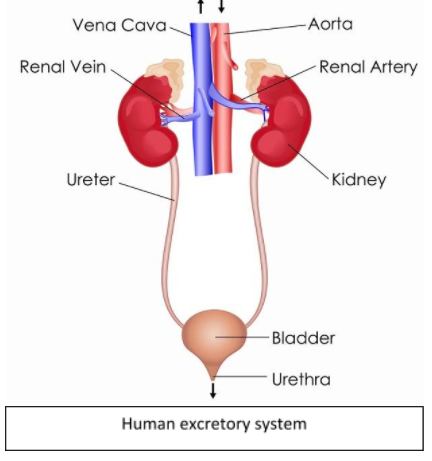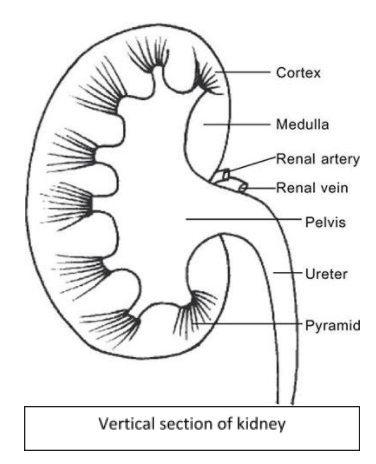
Give a brief account on the human excretory system. Add a note on the vertical section of the kidney.
Answer
483.6k+ views
Hint: Excretory system removes the metabolic wastes from body fluid or blood. It also removes excess water in the body. The main excretory organ in humans is the bean-shaped kidney which is present in a pair.
Complete answer: In humans, the excretory system removes nitrogenous waste along with other metabolic wastes from the body. It consists of few parts, viz. a pair of kidneys, renal arteries and veins, ureters, urinary bladder and urethra. The overall structure of the system is briefly discussed below.
1. The kidneys are bean-shaped organs. These are located on each side of the vertebral column. It performs the filtration blood to produce excretory fluid or urine. The structural and functional unit of the kidney is nephron. A nephron consists of: Bowman’s capsule, glomerulus, proximal tubule, Henle’s loop, distal tubule and collecting duct.
2. Renal arteries carry blood (to be filtered) to the kidneys from heart and renal veins carry filtered blood from kidneys to the inferior vena cava.
3. The kidneys open into the ureters at renal hilum. Ureters are tubes, each of which attach to a kidney and carries urine from kidneys to the urinary bladder.
4. Ureters open into the urinary bladder which is a muscular sac. These urine is stored temporarily. When filled, it contracts and passes the urine to the urethra.
5. A thin, fibro-muscular tube called urethra carries the urine from urethra to the exterior.

Note: A vertical section of kidney contains: renal cortex, renal medulla and renal pelvis. The outermost region of the kidney is the cortex which contains Malpighian corpuscles of nephrons. The inner region is called medulla. The cone shaped structures that make this part are called the renal pyramids. Collecting ducts open here. The pyramids are connected with the ureter by the renal pelvis.

Complete answer: In humans, the excretory system removes nitrogenous waste along with other metabolic wastes from the body. It consists of few parts, viz. a pair of kidneys, renal arteries and veins, ureters, urinary bladder and urethra. The overall structure of the system is briefly discussed below.
1. The kidneys are bean-shaped organs. These are located on each side of the vertebral column. It performs the filtration blood to produce excretory fluid or urine. The structural and functional unit of the kidney is nephron. A nephron consists of: Bowman’s capsule, glomerulus, proximal tubule, Henle’s loop, distal tubule and collecting duct.
2. Renal arteries carry blood (to be filtered) to the kidneys from heart and renal veins carry filtered blood from kidneys to the inferior vena cava.
3. The kidneys open into the ureters at renal hilum. Ureters are tubes, each of which attach to a kidney and carries urine from kidneys to the urinary bladder.
4. Ureters open into the urinary bladder which is a muscular sac. These urine is stored temporarily. When filled, it contracts and passes the urine to the urethra.
5. A thin, fibro-muscular tube called urethra carries the urine from urethra to the exterior.

Note: A vertical section of kidney contains: renal cortex, renal medulla and renal pelvis. The outermost region of the kidney is the cortex which contains Malpighian corpuscles of nephrons. The inner region is called medulla. The cone shaped structures that make this part are called the renal pyramids. Collecting ducts open here. The pyramids are connected with the ureter by the renal pelvis.

Recently Updated Pages
Master Class 11 Accountancy: Engaging Questions & Answers for Success

Express the following as a fraction and simplify a class 7 maths CBSE

The length and width of a rectangle are in ratio of class 7 maths CBSE

The ratio of the income to the expenditure of a family class 7 maths CBSE

How do you write 025 million in scientific notatio class 7 maths CBSE

How do you convert 295 meters per second to kilometers class 7 maths CBSE

Trending doubts
The Equation xxx + 2 is Satisfied when x is Equal to Class 10 Maths

Why is there a time difference of about 5 hours between class 10 social science CBSE

Change the following sentences into negative and interrogative class 10 english CBSE

What constitutes the central nervous system How are class 10 biology CBSE

Write a letter to the principal requesting him to grant class 10 english CBSE

Explain the Treaty of Vienna of 1815 class 10 social science CBSE




